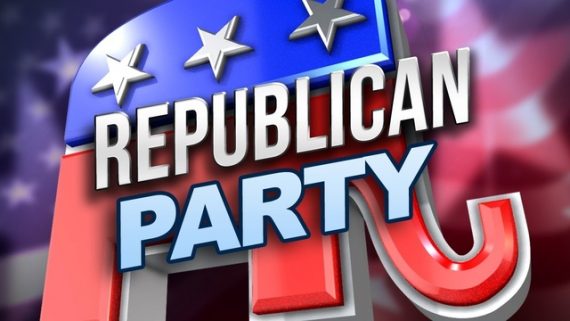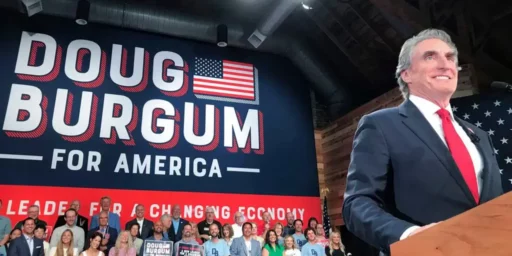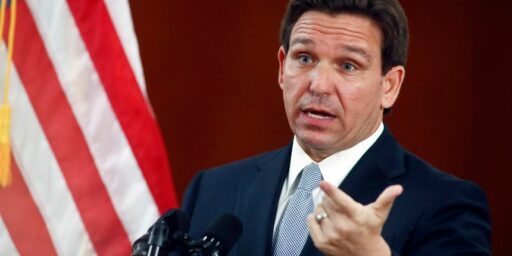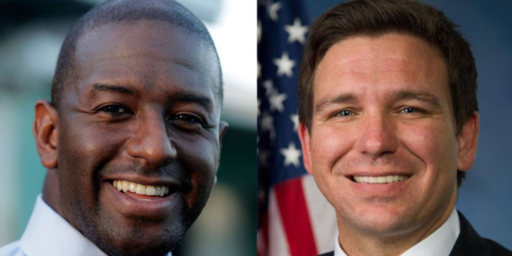Who?
Another hat for the pile.

The WSJ reports: North Dakota Gov. Doug Burgum Poised to Enter GOP Presidential Race
North Dakota Gov. Doug Burgum is poised to enter the Republican presidential nomination race and is planning a June 7 event in Fargo, N.D., to make a major announcement, sources familiar with his plans told The Wall Street Journal.
The wealthy former software entrepreneur from a heavily Republican state is expected to join a rapidly expanding GOP field that added two entrants, Sen. Tim Scott of South Carolina and Florida Gov. Ron DeSantis, this week.
This just adds to the list that James Joyner noted earlier in the week.
I am not going to bother digging into Burgum’s chances or significance. I think that the assessments there are pretty obvious.
Rather, I will take the opportunity to note what this says about the weakness of American parties and the degree to which they are controlled not by centralized decision-making, but instead by the choices of individuals.
Moreover, it shows the state of American politics (which is a long-standing one) wherein if your faction wants to challenge for power, you feel constrained to do so within the existing structure. There is no incentive for even low-level politicians (an assessment that definitionally applies to the governor of one of the Dakotas) to create new parties to gain attention. It is almost always considered a better bet (long shot though it may be) to be a player of some kind (whether an outside shot at being the nominee, the veep, a cabinet selection, etc.) is to do so from within one of the two major parties.
And, of course, a major reason this is the case is illustrated by this story: the price of entry into the club is just saying you want in. Moreover, that price is cheaper than forming a new party (plus the press treats you with more seriousness than if you formed a third party).
Setting aside the discussion of Burgum and the gaggle of candidates destined to poll solely in the single digits. What would be happening right now if the Republican Party actually controlled its label? The answer would be almost certainly that Trump would be the nominee. That would mean that if DeSantis really wanted to be president he and his $100 million would have to form his own party to run. Likewise, all of the other third-tier (at best) candidates would have to decide whether they wanted to go third party or not. Indeed, we would probably have fewer people running, but likely more parties in operation.






He was actually on that list (which was Weigel’s) but, yeah. He may be a fantastic governor but he has zero national profile if you and I haven’t heard of him.
@James Joyner: Just goes to show much I pay attention to the minor candidates 🙂
North Dakota, for most of the COVID pandemic, held the US record for infections per capita.
In a normal world that would be disqualifying.
How much of the disincentive to creating a new party is the difficulty in qualifying in 50+ states? If there was a single qualification to appear in a Federal election would we see more parties? It seems that would be something that could be achieved.
@Tony W:
“North Dakota, for most of the COVID pandemic, held the US record for infections per capita.
In a normal world that would be disqualifying”
Not for a Republican primary. It is a selling point there.
And remember that they bill themselves as the Party of Life.
According to this site, COVID deaths per million were lower in North Dakota (3298) than the national average (3520). (If that site is completely wrong, I’d appreciate an explanation, and a link to better data. I referred to it often during the peak of the epidemic, because I like the “big table” presentation of the data.)
North Dakota should have done better, since it is a rural state, but the population there is older than the national average.
@MarkedMan:
Honestly, I don’t think it would be a barrier to either a popular one-off candidate (e.g., Ross Perot in 1992) or a well-heeled would-be candidate (ala Mike Bloomberg in 2020). Elon Musk could qualify in all 50 states by the end of the month if he wanted. And, hell, Teddy Roosevelt did it (granted, with only 48 states) way back in 1912, well before television, much less the Internet.
The problem is that, in all but two states, Electoral votes are winner-take-all. That just gives an inordinate structural advantage to the two major parties. Even though he was quite popular, Perot got 0 Electors. The last non-major-party candidate to win a state was George Wallace in 1968. The last before that was Strom Thurmond in 1948. (There have been a handful of one-offs, where a faithless Elector cast a ballot for someone who didn’t win a state, but they were meaningless an a-systemic.)
@James Miller: WorldOMeter is what I’ve relied upon as well. Yes, weird data: only 3 states had a higher infection/1M rate and yet they were better than the median (32/50) in deaths/1M. Then again, there’s not that much variation in the latter—most states are in the 3000s.
@MarkedMan: Two thoughts.
1. Given the state-based system we have, these guys already have to qualify per state for the primaries, so that hurdle already exists after a fashion.
2. As James notes, a serious candidate, like DeSantis, has the money and structure necessary, so it really isn’t that big of a hurdle.
@James Joyner: And while I agree that the structure of competition in the EC incentivizes large parties, the role of the nomination process, and the weakness of parties, is a better, stronger explanation. Competitors would have no choice but to form new parties (or quit politics) if the parties were stronger.
Again, the system is currently one of almost self-selection in terms of basic entry.
@Steven L. Taylor: Yes, certainly true in that a smoke-filled room would not have chosen Trump in 2016 and would damn sure not pick him in 2020. But I don’t think Trump could have won in 2016 as the standard bearer of the MAGA Party, either. It would have just ensured Rubio/Cruz/Bush/Kasich would have lost the general, since he would have siphoned off a significant number of votes.
@James Miller: https://dangoodspeed.com/covid/total-cases-since-june
Tony – Thank you for the link. I looked at the chart there for deaths per million and it broadly agrees with what I found at worldometers. North Dakota had fewer deaths than the average for the US, as a whole.
There are good reasons to be careful about counts of both cases and deaths, but as far as I can tell, death counts are likely to be more accurate than case counts and — I assume this is not controversial — more important.
(It’s not relevant to this discussion, but I should mention that statistics from some of the nations in their world table have, shall we say, “problems”.)